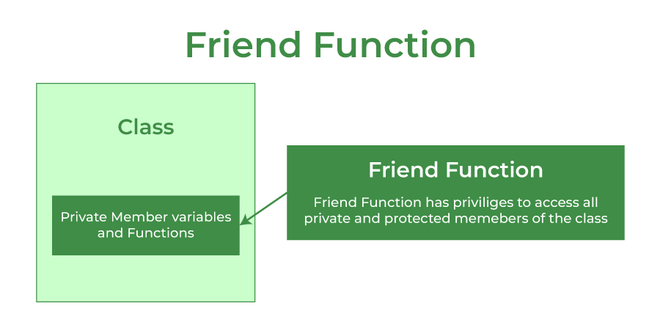
Friend Functions in C++ Explained with Example
Introduction To Friend Functions in C++
In C++, friend functions are a unique feature that offers increased flexibility in class design while maintaining encapsulation. A friend function is a non-member function that is granted access to the private and protected members of a class. This allows the function to operate on the class’s private data, even though it is not a member of the class itself. In this article, we will explore the concept of friend functions in C++, understand their syntax, and discuss the benefits of using them to achieve more robust and adaptable class implementations.
Understanding Friend Functions in C++:
In object-oriented programming, classes are designed to encapsulate data and provide public interfaces for interacting with that data. By default, only the member functions of a class can access its private data members. However, in some scenarios, allowing certain external functions access to private members can be advantageous without compromising data security. This is where friend functions come into play.
Syntax of Friend Functions in C++:
To declare a friend function in C++, the function prototype is specified within the class declaration preceded by the friend keyword.
class ClassName {
private:
// Class members here
public:
// Public member functions here
// Friend function declaration
friend return_type functionName(parameters);
};Benefits of Using Friend Functions in C++:
- Enhanced Flexibility: Friend functions can access private and protected members of a class, allowing you to implement external functions that can work closely with the class’s data. This promotes more flexible and creative class designs.
- Improved Efficiency: Friend functions can perform operations on private members directly without the need for getter and setter functions, leading to more efficient code.
- Simplified Code Maintenance: By providing selected external functions access to private data, friend functions contribute to more concise and maintainable code.
Example: Implementing a Friend Function in C++
#include <iostream>
class Rectangle {
private:
int length;
int width;
public:
Rectangle(int len, int wid) {
length = len;
width = wid;
}
// Friend function to calculate the area of the rectangle
friend int calculateArea(Rectangle rect);
};
// Definition of the friend function
int calculateArea(Rectangle rect) {
// Accessing private members directly
return rect.length * rect.width;
}
int main() {
Rectangle r(5, 3);
int area = calculateArea(r);
std::cout << "Area of the rectangle: " << area << std::endl;
return 0;
}Output:
Area of the rectangle: 15Summary
Friend functions in C++ provide a powerful tool for enhancing the flexibility and encapsulation of classes. They allow certain external functions to access private members of a class without being its members, promoting cleaner and more efficient code. By understanding the concept and syntax of friend functions, you can design more adaptable and maintainable class implementations.
Embrace the versatility of friend functions in C++ and unleash their potential to create more sophisticated and well-structured class designs.